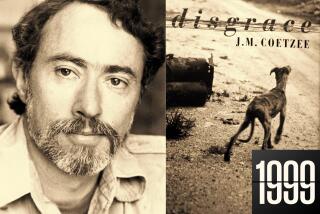BOOK REVIEW : One Leprous View of the City of Light : PARIS DREAMBOOK: An Unconventional Guide to the Splendor and Squalor of the City <i> By Lawrence Osborne</i> Pantheon $21, 210 pages
A number of intelligent readers spring to mind who would fully appreciate this very strange guide to the city of Paris. Unfortunately for the author, they’re all dead.
Henry Miller. Louis-Ferdinand Celine. Francois Rabelais. Like them, Lawrence Osborne is earthy, attracted to the grotesque and surreal, and in love with words. Like them, he’s likely to dash off on a riff of phrases at the drop of a beret. Underneath it all, he’s hostile to the satisfied, the comfortable. He’d rather be distasteful than tasteful.
For Osborne, Paris isn’t the City of Light, it’s a “luminous organism” that flares up “with the violence of a naphtha fire.” He likes slime and eyeballs popping out, and various discharges. Speaking of the city’s graffiti artists, he chooses to call them “deformed egos . . . breaking out of the latrine of anonymity where they have been forcibly kept.”
We’re talking, in these 19 colorful essays, about Paris in “the late-industrial Dark Ages.” That’s now. The speaker is a thirtysomething British man who lives off and on at No. 37 Rue Andre Antoine and has written two other books, both novels--”The Angelic Game” and “Ania Malina.”
Osborne refers to himself as “A noble leper skulking the shadows,” a “virulent rustic” and “the peasant.” Archly, he addresses us as his “dear readers” or “fellow citizens.” We know he loves the steam rooms of Paris, particularly the “smell of foul yogurt that comes with the exposure of your inner filth,” and loves the word oleic , which he uses four times. (It’s “of or obtained from oil, of oleic acid”--an oily acid used in making soap and ointments.)
He’s fascinated by the growing Arab and African population of Paris. There is, come to think of it, at least one living writer who will appreciate Osborne--T. C. Boyle. In fact, Osborne reads like T. C. Boyle strung out on brioche.
Like Boyle he resurrects odd words. Osborne loves massages from the “the axolotyl-like Hamid.” Axolotyl, if it’s not right there at the front of your brain, refers to “any of the various members of a genus of dark salamanders of Mexico that mature sexually and breed while remaining in the gilled larval stage due to a thyroid deficiency.”
Osborne reaches a peak of Rabelaisian earthiness and his own forcefulness in the essay called “The Gastronome’s Dream,” but this is not Gourmet magazine.
Osborne, referring to himself in the third person, is not exactly fond of Paris in the summer when it sizzles. “What disgusts him most about this unbearable season, aside from its blatant flirtation with the aromas of decay, is the deliberate conversion of the nucleus of his beloved City into a kind of dry aquarium for the benefit of 35 million visitors whose rollicking, inebriated plastic faces fill him with the most dandyish and unjustifiable of moral paroxysms.”
“The tourist zones,” he writes, “are heaving and unstable stomachs ingesting vast amounts of pulped material, sharks’ bellies filled with human tyres and bones and capable at any minute of reading violently against their own rapacious gourmandise , spitting up bile, burping, rumbling, throwing up or wallowing in hedonistic contentment.”
Some of this is rich and meaningful and almost all of it is original. And some of it is arch and sarcastic. Writing about the Metro, he reminisces, “Where are the forgotten attempts to scent the underground system with lemon grass in the beautiful years before the First World War?”
And further along, “Where are the wagons tacked on to the end of the trains reserved for the Jews under the Occupation and known popularly as ‘The Synagogue’?” Is he really longing for those good old days? His archness is framed, though, by the very nice idea that the Metro is “the city’s unconscious, its slumbering, nightmare-filled brain. . . .”
He has a bit more of a political agenda than simply to shock us bourgeois. He longs for the more interesting public spaces of yesteryear. Where are the baths d’antan ? “When will the public bath drive out the fatuous private bathroom and regain the gigantism of Caracalla and Diocletian”
And he wouldn’t mind saving the city along the way. Writing of the Place Pigalle, he says, “There’s no question that the City is being barbarized, that its intimacy is gradually being ironed out in favor of the creation of an empire of aggression in which the temples of food and sex will soon be as sexless and agastronomic as the cohorts of tourists that use them.”
His historic tidbits are intriguing, but too far between, and so are the real scenes he limns such as this, from his local boulangerie . “An African with a weak heart taking anti-coagulant drugs is accosted by two mentally handicapped racists who demand his seat and dies from a heart attack on the pavement outside as a result of being pushed to the ground by the two xenophobes, who have just left an asylum.”
The last time I saw Paris, as described by Osborne, her heart wasn’t young and gay. Her heart was more oleic, and I think she had a thyroid condition.
Next: Jonathan Kirsch reviews “Seizing the Enigma: The Race to Break the German U-Boats Codes” by David Kahn (Houghton-Mifflin).
More to Read
Sign up for our Book Club newsletter
Get the latest news, events and more from the Los Angeles Times Book Club, and help us get L.A. reading and talking.
You may occasionally receive promotional content from the Los Angeles Times.







